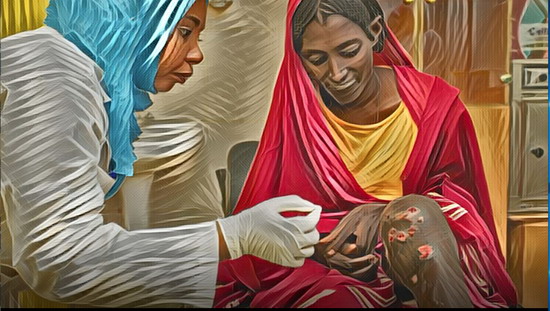
17 February 2019| Khartoum | Cairo |Geneva ‒ Delegates attending the Sixth International Conference on Mycetoma in Khartoum, Sudan, have endorsed a “call for action” urging the global community to work together with multilateral agencies, partners, research institutions and pharmaceutical companies to address the devastating consequences of this disease.
Mycetoma, a neglected tropical disease, mainly affects poor, rural populations, particularly people of low economic status who walk barefoot and manual workers, such as agricultural laborourers and herdsmen. Reaching people in these underserved areas is crucial to achieving the 2030 United Nations Sustainable Development Goals.
“I am pleased to see this global conference shedding light on mycetoma, a disease that has been truly neglected and overlooked for too long, which has resulted in devastating consequences for poor and vulnerable populations,” said Dr Ahmed Al-Mandhari, WHO Regional Director for the Eastern Mediterranean. “Tackling neglected tropical diseases and involving all stakeholders in this important scientific gathering is in line with our Vision 2023, which calls for solidarity and action towards achieving Health For All By All in the Region.”
Mycetoma commonly affects the legs and arms, causing intense suffering, loss of function and impaired ability to work to earn a living.
“Sudan is committed to investing in a healthier environment to guarantee safer livestock and agricultural practices and to engaging with farmers and livestock herders to prevent injuries that can cause mycetoma,” said His Excellency Al-Khair Al-Nour Al-Mubarak, Federal Minister of Health of Sudan. “Appropriate guidance and support is needed to raise awareness about mycetoma, including information on prevention and the need to seek early treatment of all suspected cases.” When diagnosed in its late stages, mycetoma can lead to amputation and permanent disability.
“The suffering and disability caused by mycetoma have far greater consequences for families, socioeconomic lives and mental well-being, as patients affected are often stigmatized,” said Professor Ahmed Hassan Fahal, Director of the Mycetoma Research Centre in Khartoum, WHO’s only collaborating centre on mycetoma. “Its global distribution and disabling consequences require the adoption of bold new initiatives and approaches to ensure appropriate, early diagnosis and access to enhanced treatment.”
Setting goals and milestones
Following the recognition of mycetoma as a neglected tropical disease by the Sixty-ninth World Health Assembly in 2016 through adoption of resolution WHA 69.21, global measures have been initiated, including an assessment of current policies and practices in 164 countries, a global consultation to identify priority areas of work and the establishment of a Global Mycetoma Working Group.
More work needs to be done as little is known about the incidence and prevalence of mycetoma worldwide. Documented cases show that Sudan reports one of the highest numbers of cases in the world. Other countries with relatively high numbers that form part of the so-called mycetoma belt include the Bolivarian Republic of Venezuela, Chad, Ethiopia, India, Mauritania, Mexico, Senegal, Somalia and Yemen.
“It is important we set goals and milestones that can trigger collaborative research to develop the much-needed tools and medicines to simplify diagnosis and treatment,” said Dr Mwelecele Malecela, Director of WHO’s Department of Control of Neglected Tropical Diseases. “An essential first step could be to look at how we can integrate mycetoma interventions within primary health care delivery, particularly as part of measures targeting diseases that manifest primarily on the skin.”
The way mycetoma is transmitted has not been fully elucidated. Treatment is long and costly and outcomes are often unsatisfactory, which discourages patients from reporting to health centres for care. Furthermore, no rapid diagnostic tests are available for use within the primary health care system.
Investigating a new antifungal
The global community is hopeful as the Drugs for Neglected Diseases initiative (DNDi) investigates the efficacy of fosravuconazole, a medicine that could be used for treatment of mycetoma. If successful, it could provide a short, cost-effective therapeutic protocol and boost compliance with treatment for mycetoma. Until that happens, however, the only strategy to reduce the severity and consequences of mycetoma is through enhanced public awareness, early detection of cases and continued care and treatment.
The three-day conference in Khartoum, organized by the Government of Sudan and WHO, consists of plenary sessions, thematic sessions, group work and meet-the-experts sessions; an estimated 500 participants will review control activities, clinical aspects and research related to the disease.
First global workshop
The Sixth International Conference on Mycetoma was preceded by the First International Training Workshop on Mycetoma from 10 to 14 February 2019. The workshop was organized by WHO and the Mycetoma Research Centre with the support of DNDi.
More than 60 health staff from a wide range of countries where mycetoma is endemic participated in discussions on standardizing practices on diagnosis, treatment, epidemiology and surveillance.
The disease
Mycetoma is characterized by disabling deformities and is associated with severe morbidity. It is a chronic, granulomatous, progressively destructive inflammatory disease of the skin, connective tissue, muscle and bone.
The disease results from infection caused by more than 70 microorganisms of bacterial or fungal origin. Mycetoma is classified as actinomycetoma (bacterial mycetoma) or eumycetoma (fungal mycetoma) based on its causative agent.
If not detected and managed early, mycetoma can cause gross deformity of the limbs and, in advanced cases, lead to amputation and death. Understanding the etiology and risk factors of the disease will enable the development of relevant preventive measures.


